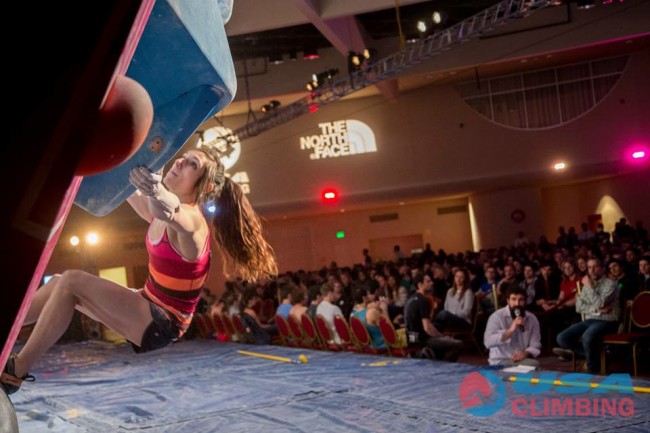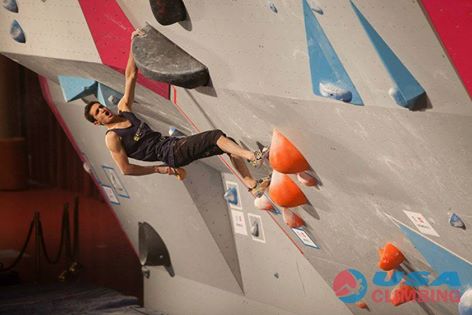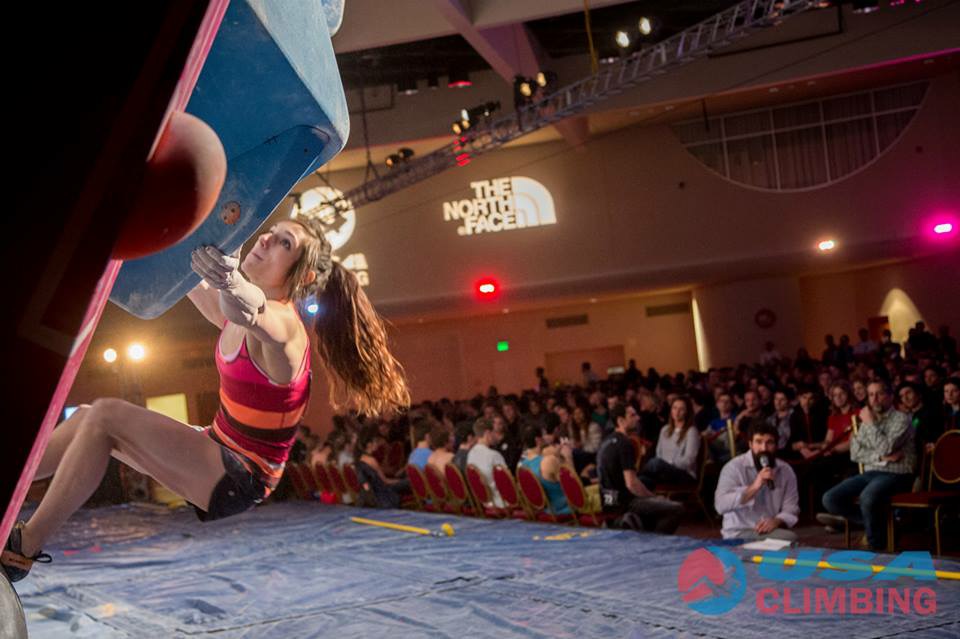
Written by Mike Helt
In Andrew Bisharat’s recent Rock and Ice editorial, “Why Comp Climbing Is Not The Future” the author claims to know where the world of climbing is headed, and it’s not to the competition arena.
Bisharat informs his readers that comp climbing was supposed to be the “bright, shining future child of our great sport,” but it has failed to live up to its reputation. Instead comp climbing has become, “more like climbing’s pet.” A proverbial barking dog. His basis for thinking this has to do with the recent ABS Open National Championships held in Madison, Wisconsin and the new scoring system for bouldering comps that USA Climbing instituted this year.
Bisharat seems a bit confused as to which argument he would like to make in his editorial. Is it that comp climbing has not lived up to the supposed hype, or is it that the new scoring system is difficult to understand and has flaws? Or perhaps a combination: comp climbing is never going to be the future of climbing because if you need a scoring system to figure out who is the winner, the audience won’t understand it.
He said as much, in a more demeaning way, back in a 2009 blog post about competitions. “My sense is that most comps are currently too abstract, demanding too much memory and understanding of its spectators. People are generally stupid, and they want their entertainment to be mindless and themselves to be smashed,” Bisharat wrote.
Like those that once called sport climbing neither, and those that called bouldering a fad, Bisharat has joined the ranks of naysayers saying this or that aspect of climbing will never last. Yet today, the popularity of sport climbing has overtaken trad and alpine climbing, while bouldering has skyrocketed in popularity and indoor bouldering facilities are the fastest growing segment of the climbing gym industry. Fortune tellers are a rueful bunch indeed.
Scoring: Flawed But Fair
It seems that Bisharat’s main point is that the scoring system used by USA Climbing for the ABS season is dysfunctional and extremely hard to understand. In fact many across the blogosphere feel the same way. Yet those that have studied it have come out in favor of the new scoring, including pro-climber, math wizard and Rubiks cube master, Matt Wilder who is undoubtedly one of the smartest climbers in the US. Wilder starts off a recent blog post by writing, “Bouldering is too nuanced to ever be perfectly scored.” After explaining why this new system is fair he concludes, “This new scoring system is completely reasonable and may prove to produce more consistent results than previous methods.”
Both Wilder and Justin Meserve of Crank Chronicles have painstakingly broken down the math that USA Climbing used at Nationals, which thankfully means we don’t have to. What they both find is that the scoring system is flawed but workable, and in the history of bouldering comps this new system is the fairest.
Wilder writes, “I agree that it’s a bit complex for the viewer to follow, but none of the other methods are that easy to follow either unless you’ve been watching comps for years.” Agreed. Bouldering is complex with a lot of variables that must be factored in if we are to determine who is the better climber: multiple problems, tops, points-per-hold and attempts. The two other basic forms of scoring bouldering problems, points-per-hold only and the IFSC “bonus” method have inherent weaknesses that USAC’s new system attempts to mitigate.
Since bouldering is a bit more complicated than route climbing — where athletes are scored on only one attempt of one route — it makes sense in bouldering to score the climber across the entirety of the competition. “One thing I like about this new method is that it strives to assess the difficulty of each problem in a way that is relative to all the climbers,” wrote Wilder. Meserve agrees and writes, “The new system rewards competitors for doing consistently better than the others, across multiple problems.”
With the help of these two math geniuses we see that the scoring system is fundamentally more fair than any system before it. That still doesn’t solve the problem of knowing who is winning. “Its hard as hell to follow from home without a calculator,” Meserve points out. Thus the most obvious solution is to show live scores. My guess is that everyone, even USAC, would agree this is the logical next step.
So really the problem is not with the scoring (though there will always be room for improvement), it’s really that USAC’s budget and technology have not caught up with the demands of the viewer. This does not imply that comp climbing is going nowhere fast, rather, it proves that comp climbing has a lot of opportunity for innovation and growth.
USAC has been growing and innovating every year. I remember a time when ABS Open Nationals was held in cramped and dirty climbing gyms with inadequate padding, an inadequate hold supply, inadequate everything. I’ve heard stories about National routesetters sleeping two-to-a-bed in sketchy motels, and you had to wait until after the event to see the results and a few photos. Now the event has a custom designed bouldering wall, setters have better accomodations and the access to the newest climbing holds on the market, and anyone, anywhere can live-stream ABS and SCS Open Championships from the comforts of their couch!
All these changes happened because people stepped up to the plate and offered to help either with their hands or with their wallets. These people saw a need and instead of criticizing behind their computer screens took their diverse skills and connections and made shit happen.

To See the Future, Follow the Numbers
Right now climbing competitions in the US are dominated by youth climbers. There were 111 youth bouldering and 82 youth rope-specific competitions in this past season, versus only two sanctioned adult events (ABS and SCS Open Nationals) and a handful of local circuits. Almost every climbing gym in the country has a youth competitive team and those teams are seeing record participation. Gear makers are sponsoring entire teams with matching duffles and jerseys. USA Climbing has had to re-distribute their regions several times because of overcrowding within the regions.
With numbers taken from the USAC website, CBJ found that ABS youth participation at the Regional Championships grew by 22% and SCS youth participation grew by 15% year-over-year. That far outstrips the growth rate of climbing gyms, which shows that more teams are being formed and those teams are getting bigger.
It’s not just the youth that are pushing competitions to the forefront. Anyone over the age of 16 can sign up to compete at the ABS Open National Championships; there is no qualification or requirement to participate. In 2011, 79 athletes signed up for the ABS Open and by 2014 that number grew to 132.
Participation is only one aspect of the competition statistics. This year’s ABS Open and Youth Nationals was live broadcast on the internet by Louder Than Eleven to rave reviews. Viewership numbers obtained from LT11 show that 43,160 viewers watched Open Finals and 144,022 watched Youth Finals during the live broadcast, and many more people have since watched replays.
The Future?
Will comp climbing be the future? Nobody knows what the future will bring and if they tell you, even in a well written and witty article, they are deceiving you. What we do know is that comp organizers will innovate and create bigger and better competitions that will be shown to a broader audience than anyone ever thought possible. Competitors will continue to show up for the game ready to take the podium.
Competition climbing is not for everyone. That’s what is so great about the wide ranging sport of climbing. Each climber gets to decide how they want to interact with the wall and as long as they’re loving it and living it passionately than the world is a better place.
Criticism only gets us so far. If you do like competitive climbing and want to see it reach its full potential, then call up your local climbing gym and ask them how you can help during their next competition.

Climbing Business Journal is an independent news outlet dedicated to covering the indoor climbing industry. Here you will find the latest coverage of climbing industry news, gym developments, industry best practices, risk management, climbing competitions, youth coaching and routesetting. Have an article idea? CBJ loves to hear from readers like you!







